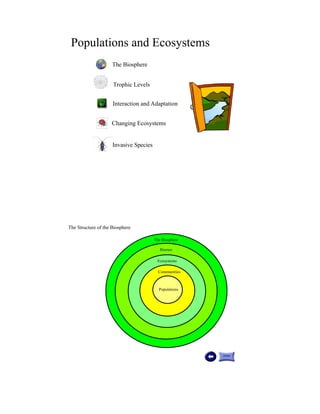
Populations and Ecosystems
- 1. Populations and Ecosystems The Biosphere Trophic Levels Interaction and Adaptation Changing Ecosystems Invasive Species The Structure of the Biosphere The Biosphere Biomes Ecosystems Communities Populations
- 2. The Biosphere: The part of the Earth where living organisms and organic matter exists The biosphere includes all areas that contain life, which include the hydrosphere (water environments) the atmosphere (air environments)and the geosphere (ground and soil environments). Anywhere that humans habitat is called the anthrosphere. Biome: Regions of the Earth that share similar climates, vegetation and animal life. The life found in these regions are specially suited for survival in that particular environment. There are six main biomes Freshwater Marine Desert Forest Grassland Tundra Of course, these can be divided up into more specific biomes such as tropical rain forest, temperate rain forest, coniferous forest, and so on...
- 3. Ecosystems: Living organisms interacting with each other and the non-living factors in an environment Abiotic vs. Biotic factors Communities All the interacting living organisms within an ecosystem (Animal, plant, fungi...)
- 4. Population: The total number of organisms of one species that live in a particular ecosystem at one time Abiotic Factors: All the non-living parts of an environment Biotic factors: All the living factors of an environment
- 5. Organic Matter: Matter that has come from a once-living organism; capable of decay, or is the product of decay Characterized by molecules that contain both carbon and hydrogen (hydro-carbons) Inorganic Matter: Matter from a non-living source such as rocks, sand or plastic; Molecules do not contain both carbon and hydrogen Trophic Levels Energy and the Trophic Pyramid Energy is the ability to do work. All living things need energy to survive. This shows how energy is distributed in an ecosysem. Energy starts at the bottom of the pyramid with the producers and works its way up to the upper levels. Tertiary Consumers Secondary Consumers Primary Consumers Primary Producers Let's look at some examples...
- 6. It's all a matter of mathematics. An organism can only survive if there is enough energy available in the trophic level below it.
- 7. Interaction and Adaptation Interactions: How organisms respond or behave around other organisms Competition: The struggle to obtain various limited resources within the environment. Resources can include: · Water · Food · Living space (habitat) · Light energy · Reproduction Can take place between individuals of the same species or different species
- 8. How might plants compete with each other? Symbiosis: Individuals of different species that have a close relationship with each other
- 9. Mutualism: The interaction between two different organisms of different species where both benefit Commensalism: The interaction between two different organisms of different species where one benefits and the other is unaffected
- 10. Parasitism: The interaction between two different organisms of different species where one benefits and the other is harmed Adaptation: Helps organisms survive and thrive in their particular habitat Adaptations come from variations within the species. If an organism is born with a sightly different trait (a longer beak, a slightly darker color, etc.) that gives it a survival advantage, the organism is more likely to survive and pass that trait onto its offspring The trait can provide an advantage to surviving... - In a particular climate - In a particular habitat - A predator - By finding/obtaining a food source A change in any of these can cause one trait to become less or more advantageous.
- 11. There are two types of adaptations: Behavioral Adaptations: A way an organism behaves or interacts that gives an organism a survival advantage in a specific ecosystem or habitat Moving in large groups is a behavioral adaptation; it helps protect the members of the group from predators. Structural Adaptations: A physical characteristics that gives an organism a survival advantage in a specific ecosystem or habitat An arctic fox has a thick fur coat that helps it survive in extremely cold weather. It is also white, so it blends in with the snow. A red fox is not able to hide from its prey in that environment, so it is not as successful. Natural Selection: The process in which individuals members of species are "selected" by the environment for survival because variations that give the individual an advantage. These genetic variations make it more likely that an organism will survive and therefore pass on the successful trait to its offspring. The result is a slow change in the species over many years.
- 12. Changing Ecosystems Populations change: All populations change over time: Grow or Decline --Birth rates --Available food --Predators and prey interactions Limiting Factors: Factors or conditions in the environment that limit a population's size Examples: Predator/prey relationships? Reproductive? Available Resources? Seasons? Carrying Capacity The maximum number of individuals that an ecosystem can support Ecosystems Change Over Time Succession: Gradual change of an ecosystem when one community replaces another. Primary Secondary